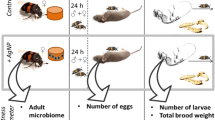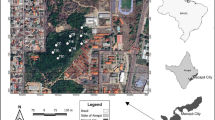Abstract
Whole-carcass residues of the rodenticide zinc phosphide (Zn3P2) and hydrolyzed phosphine (PH3) were determined for voles (Microtus spp.) that died following ingestion of a 2% Zn3P2 steam rolled oat (SRO) groats bait. Procedures involved: a three-day acceptance test to assess vole consumption (n=27) of control SRO groats and several one-day Zn3P2- (n=13) or control-bait (n=4) tests to characterize onset of pharmacotoxic signs and to obtain fatally-dosed carcasses for residue analyses. Carcasses were stored in liquid nitrogen (LN2) to maximize retention of Zn3P2/PH3 residues prior to chemical determinations. Linear regressions were computed between pairs of consumption and residue variables. Main results were the following: (1) mean (±SD) consumption of control bait was 2.5 (±0.9), 3.0 (±0.9), and 2.8 (±0.8) g on days 1, 2, and 3, respectively (≧10.6 ± 4.6% of body weight); (2) all test-bait voles (n=13) died ∼4–12 h after bait presentation, with lethargy and respiratory distress key signs of toxicosis; (3) whole-carcass Zn3P2 residues averaged 1.73 mg (minmax: 0.31–4.95), and PH3 residues averaged 10.6 μg (minmax: 0.5–21.0); and (4) significant linear regressions were found between bait consumption/Zn3P2 intake and body weight (r2=0.64, p≦0.001), carcass Zn3P2 and bait consumption/Zn3P2 intake (r2=0.32, p≦0.043), and carcass Zn3P2 and body weight (r2=0.60, p≦0.002). Certain analytical and hazards issues are discussed.
Similar content being viewed by others
References
Bell HB (1972) The hazards of secondary poisoning from zinc phosphide to selected vertebrate species. Unpubl MS thesis, University of Tennessee, Knoxville, TN, 33 pp
Bell HB, Dimmick RW (1975) Hazards to predators feeding on prairie voles killed with zinc phosphide. J Wildl Manage 39(4):816–819
Berck B, Gunther FA (1970) Rapid determinations of sorption affinity of phosphine by fumigation within a gas chromatographic column. J Agric Food Chem 18(1):143–147
Chan LTF, Crowley RJ, Delliou D, Geyer R. (1983) Phosphine analysis in post-mortem specimens following ingestion of aluminum phosphide. J Anal Toxicol 7(4):161–208
Childs JE, Ksiazek TG, Rollin PE, Krebs JW, Zaki S, Nichol ST, Peters CJ, Glass GE (1994) Hantaviruses and their rodent reservoirs in the United States. Proc Vertebr Pest Conf 16:188–191
Gratz NG (1973) A critical review of currently used single-dose rodenticides. Bull Wld Hlth Org 48:469–477
Hilton HW, Mee JML (1972) Studies with radioactive phosphine-32P in sugarcane. J Agric Food Chem 20(2):334–336
Hood GA (1972) Zinc phosphide—A new look at an old rodenticide for field rodents. Proc Vertebr Pest Conf 5:85–92
Marsh RE (1988) Relevant characteristics of zinc phosphide as a rodenticide. Great Plains Wildl Dam Cont Wkshp Proc 8:70–74
Nowicki TW (1978) Gas-liquid chromatography and flame photometric detection of phosphine in wheat. J Assoc Offic Anal Chem 61(4):829–836
SAS Institute (1987) PROC PEG. In: Parker JC (ed) SAS/STAT™ Guide for Personal Computers (Version 6). SAS Institute, Inc, Cary, NC, pp 1–18
Tabata K (1986) Decomposition of the rodenticide Zn3P2 and its acute toxic symptoms in red-backed wood mice (Apodus speciosus)(in Japanese). J Jpn For Soc 68(1):26–31
Terzić Lj (1984) Spectrophotometric determination of zinc phosphide in technical products and tissues from poisoned animals. Acta Vet (Beograd) 34(2–3):97–103
Tkadlec E, Rychnovsky B (1990) Residues of Zn3P2 in the common vole (Microtus arvalis) and secondary poisoning hazards to predators. Folia Zool 39(2):147–156
Winer, BJ (1971) Statistical principles in experimental design (2nd Edition). McGraw-Hill, NY, pp 44–48, 261–283
Author information
Authors and Affiliations
Rights and permissions
About this article
Cite this article
Sterner, R.T., Mauldin, R.E. Regressors of whole-carcass zinc phosphide/phosphine residues in voles: Indirect evidence of low hazards to predators/scavengers. Arch. Environ. Contam. Toxicol. 28, 519–523 (1995). https://doi.org/10.1007/BF00211636
Received:
Revised:
Issue Date:
DOI: https://doi.org/10.1007/BF00211636




